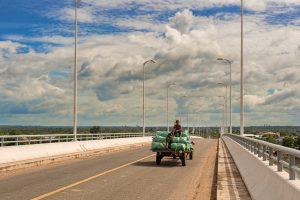A recent Lowy Institute report on Southeast Asia’s engagement with Chinese development finance provides a useful foundation for understanding how the region is managing an evolving aid environment. Chinese development finance to Southeast Asia has declined significantly since 2015, yet the region’s governments are not retreating from engagement. Instead, they are exercising greater discretion in how they work with Beijing.
By categorizing responses as constrained, restrained, and opportunistic, the report highlights the fact that Southeast Asian states are not passive recipients of development assistance. Their choices reflect their domestic needs, external options, and broader foreign policy strategies. The situation for each country concerns not only the volume of Chinese aid and financing that they receive, but how they are actively shaping development partnerships in order to advance national priorities.
Vietnam is one such case. Although often seen as cautious in its dealings with China, its decision earlier this year to approve an $8.3 billion railway connecting Hai Phong, Hanoi, and Lao Cai, a city on the Chinese border, suggests a more nuanced approach. The railway fits into China’s broader Pan-Asia rail network and has been acknowledged by Vietnamese authorities as part of the Belt and Road Initiative. This does not indicate a reversal in policy. It shows that Hanoi is willing to engage when the opportunity aligns with its national interests, particularly in critical infrastructure where connectivity serves both economic and strategic goals. This has been consistent with its long-standing foreign policy approach: to diversify partnerships but avoid overdependence.
Timor-Leste offers a different, but equally instructive, example. While it receives only modest levels of Chinese aid and financing, it has welcomed symbolic projects, including China’s construction of the Presidential Palace and Foreign Ministry headquarters. At the same time, Dili has actively pursued investment from a range of partners. It has secured funding from Australia and Japan for transport and energy infrastructure and entered into cooperation agreements with China on digital and green development. While President José Ramos-Horta has publicly stated a preference for Australian and Japanese firms in the case of major resource projects such as the Greater Sunrise offshore gas project, the country continues to leave the door open for other partners and investors.
This is not a case of indecision. It is an example of how smaller states are using external competition to improve their negotiating position. By keeping their options open, countries like Timor-Leste are shaping the development agenda on their own terms.
This moment presents both an opportunity and a warning for Western partners. China is not stepping back entirely. Rather, it is recalibrating its development finance strategy. The emphasis has shifted from high-volume disbursements to smaller, more focused investments that deliver strategic value. These investments are more likely to be integrated, visible, and aligned with China’s long-term interests and the immediate infrastructure or development needs of the recipient nations.
Western donors face their own fiscal constraints. But if reductions in aid budgets come without a clear strategic framework, they risk undermining the very agency that Southeast Asian countries have worked to assert. The region has so far benefited from a more competitive development landscape. If Western support becomes less reliable, China may once again become the default option, not because it is preferred, but because alternatives fail to materialize.
The way forward is not to outspend China; it is to maintain credible and targeted development finance that meets the region’s priorities. That means investing in sectors that regional governments have identified as essential. These include infrastructure, green energy, economic resilience, and state-building. It also means maintaining a presence that is consistent and politically attuned.
Southeast Asian countries have made it clear that they are willing to hedge, to restrain, or to embrace depending on their particular situation. Their choices are strategic. The question now is whether their partners are willing to do the same. Not just by disbursing funds, but doing so with consistency, clarity and respect for the agency that these governments are now exercising with growing confidence.
The views expressed in this article are the author’s own and do not reflect those of his workplace and affiliated institutions.

































